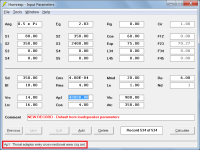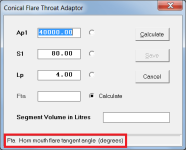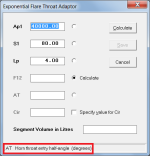Hello David,The amount of work required to fully integrate the feature would be massive - it's not going to happen!
As an alternative, is it possible to allow modeling of systems without drivers in hornresp? The acoustic circuit would be the same but the driver element would be absent. That way, the behavior of the horn/chamber/TL can be studied before it's coupled with the driver. This can make the design process less complicated and less non-linear. The code for the circuit is already present and (I imagine that) it is simpler to remove an element from the circuit.
Edit: Grammar correction etc.
I mean why does the curve shape change when we only change the Re of one speaker (2 to 8 in my case)
Because the specification of the driver has changed. The driver voice coil dc resistance is different.
and not when the Re changes with 2 speakers (2 to 8 when going from parallel to series, wich only changes the level) ?
Because the specification of the driver has not changed. The driver voice coil dc resistance is the same. The only difference is that two of the drivers have been connected in series or parallel.
And for my drawings i'd also like to know how to get the Lc number when the cabinet has a weird shape.
All you can do is to make an educated guess. The system model shows you how Hornresp thinks that the system is configured. The closer you can get to that ideal, the more accurate will be the simulation predictions.
I also wanted to know if we mount the speakers 180° (as an isobaric) would work like a normal dual driver vented chamber when ported (so not isobaric then) but that's off topic.
Agreed, it has nothing to do with Hornresp. A subject for another thread...
I managed to bring up the throat adaptor wizard by clicking on Ap1 text box, but I dont understand the meaning of the paramaters (what they refer to) Ap1, S1, Lp, Fta in the conical adapter and the whole list in the Exp adapter wizard.
The meanings are given in the Help file, and can also be seen by moving the mouse over an input box, as shown in the attachments.
( I noticed a bug in the wizard which will be fixed in the next update - the Ap1 description is not being displayed).
Also no matter what values I input in the wizard, the adapter is not displayed, it is alway a 2 segments horn, not 2 segments + adapter.
It is necessary to specify a throat chamber for the adaptor to connect to. For obvious reasons, the adaptor cannot connect direct to the driver diaphragm.
Attachments
is it possible to allow modeling of systems without drivers in hornresp?
No.
The acoustic circuit would be the same but the driver element would be absent. That way, the behavior of the horn/chamber/TL can be studied before it's coupled with the driver.
Without a drive element of some sort there will be no output, and hence no behaviour to study.
David, discussing compression drivers you mentioned that when the vel option is selected the driver parameters are disregarded.Hello David,
As an alternative, is it possible to allow modeling of systems without drivers in hornresp? The acoustic circuit would be the same but the driver element would be absent. That way, the behavior of the horn/chamber/TL can be studied before it's coupled with the driver. This can make the design process less complicated and less non-linear. The code for the circuit is already present and (I imagine that) it is simpler to remove an element from the circuit.
Edit: Grammar correction etc.
Isn't this what Giri is talking about ?
Thank you for the clarification regarding the throat adaptor. I will look into the help file more carefully
Last edited:
Isn't this what Girl is talking about ?
I assumed that Giri knew about the Vel and Acc options, but wanted no drive element at all.
The Vel and Acc options have limitations in that they are not available in all cases, and the Filter Wizard cannot be used with them.
@DJ Stifff, @David McBean Please correct me if I am wrong, but it seems to me that a dual voice coil can be wired in series or in parallel, and the impact on impedance would be identical whether the wiring applies to two voice coils on the same driver or two voice coils on different drivers/speakers. It seems to me that the impedance being faced by the amplifier is... the impedance whether it is one or the other. Can anyone please confirm this for me? I'd like to know simply because I am having some speakers manufactured for me right now with dual voice coils, and it would be nice to confirm this. The manufacturer was asking if I would like two terminals on each driver or one, and I'm afraid that by telling them one I was unnecessarily limiting my wiring options in the future.
I meant the only output being the resonance frequency.Without a drive element of some sort there will be no output, and hence no behaviour to study.
Because the specification of the driver has changed. The driver voice coil dc resistance is different.
Because the specification of the driver has not changed. The driver voice coil dc resistance is the same. The only difference is that two of the drivers have been connected in series or parallel.
Ok thanks a lot, my projects should work then.
I'll estimate, then try and adjust if i need for the LC.
There shouldn't be any difference for the amp if it's 2 separate drivers of x ohms or one driver with 2 voice coils of x ohms with the same wiring.@DJ Stifff, @David McBean Please correct me if I am wrong, but it seems to me that a dual voice coil can be wired in series or in parallel, and the impact on impedance would be identical whether the wiring applies to two voice coils on the same driver or two voice coils on different drivers/speakers. It seems to me that the impedance being faced by the amplifier is... the impedance whether it is one or the other. Can anyone please confirm this for me? I'd like to know simply because I am having some speakers manufactured for me right now with dual voice coils, and it would be nice to confirm this. The manufacturer was asking if I would like two terminals on each driver or one, and I'm afraid that by telling them one I was unnecessarily limiting my wiring options in the future.
But the way you wire a dual voice coil will have an impact on the speaker characteristics (which is not the case with 2 single voice coil drivers).
Did it answer your question ?
@DJ Stifff I believe you've answered my question, that is, when referring to a single driver, some T&S parameters and other specs may stay the same, such as Qes, Qts, response, etc., but the power handling capacity, BL, Cms, Vas, and others could be halved or doubled, as the case may be, for that driver. This is what you're referring to? And I'll need to ascertain the differences and be sure I'm using the right specs when configuring the drivers and inputting data into Hornresp or other apps to simulate system characteristics. What's interesting to me is that I want to use two 4 ohm drivers (very hard to find, thus having them manufactured) in Series to get my impedance to 8 ohm, and as hard as they are to find, there may be some additional options if I can configure the drivers independently. I am finding that the starting place to picking a driver is the Qes, because this is the least negotiable of all T&S parameters as it does not change regardless of how speakers are wired, and that by wiring two drivers in series (instead of parallel as seems to be the common wisdom to enhance bass output) I can double BL to a far better number, halve Cms to release stress on the cone at high volumes, add 3 dB to sensitivity with the effect of halving my amp demands and making the system more attractive to tube amps, double my Sd and Vd to enhance bass, and double the watts/power handling capacity. I had never before considered wiring in series as a way to enhance all sorts of things, but to do it you've either got to start with 4 ohm speakers, or use 4 speakers in parallel-series wiring, and while I can easily use 2 speakers, using 4 was too massive a cabinet. I hope I've got this right. @David McBean, @DJ Stifff anything more to add or comments?
Put the driver at the open end of the TL Instead?I meant the only output being the resonance frequency.
Another thing I do not understand is: Why do people always seem to assume that in an Isobaric the speakers are 180-degree out of phase, or front-to-back, or clamshell configuration? To me, this always means either the area of one cone is wasted (1/2 the Vd and bass) or phasing issues. Why don't more designers build the very tight minimalist enclosure around the rear of both drivers facing in the same direction? say, one right above the other, with the two drivers both loading a horn? Obtaining all the benefits of wiring whether series or parallel, Isobaric, double the cone area, horn loading, and no phasing problems? I see this configuration only rarely. Why don't more do it this way? To me the benefits are simple. What am I missing here? These are questions I have long wondered about, and maybe here at DIYaudio someone might confirm them for me or tell me what I am missing.
Last edited:
You are describing the limited imagination of the industry. Many engineers are not that knowledgable. University does not teach individualism, it teaches conformity. Second you have the sales department that wants something that they can feel comfortable with. And finally you have the public that likes to have something that Joe or Pedro has.Another thing I do not understand is: Why do people always seem to assume that in an Isobaric the speakers are 180-degree out of phase, or front-to-back, or clamshell configuration? To me, this always means either the area of one cone is wasted (1/2 the Vd and bass) or phasing issues. Why don't more designers build the very tight minimalist enclosure around the rear of both drivers facing in the same direction? say, one right above the other, with the two drivers both loading a horn? Obtaining all the benefits of wiring whether series or parallel, Isobaric, double the cone area, horn loading, and no phasing problems? I see this configuration only rarely. Why don't more do it this way? To me the benefits are simple. What am I missing here? These are questions I have long wondered about, and maybe here at DIYaudio someone might confirm them for me or tell me what I am missing.
So, use you brain. Try stuff. It will work. If not better, work as well. And it will be yours.
I don't understand why one would use an isobaric system these days?
All can be actively corrected, which gives a similar results and saving you one extra driver + the mechanical hassle to get that all nice.
To me the benefits are very obsolete at this point.
Another point you're missing, is that in a push-pull config (=isobarik) you DON'T double the Sd.
Technically you just half the Vas, or practically speaking the total volume of the cabinet.
At the cost of a lower total maxSPL (halving VAS results with a -3dB less sensitivity)
An isobarik setup is only beneficial when you can only manipulate passively and can't find any drivers that won't fit in a certain volume.
Back in the 80s/90s this was quite handy because of the enormous cabinets a lot of drivers needed.
Also the sensitivity back in the days of those woofers was quite decent, so you often could spare 3dB.
But we are way past that point.
So, to answer your own question, you're missing quite a lot here, sorry.
All can be actively corrected, which gives a similar results and saving you one extra driver + the mechanical hassle to get that all nice.
To me the benefits are very obsolete at this point.
Another point you're missing, is that in a push-pull config (=isobarik) you DON'T double the Sd.
Technically you just half the Vas, or practically speaking the total volume of the cabinet.
At the cost of a lower total maxSPL (halving VAS results with a -3dB less sensitivity)
An isobarik setup is only beneficial when you can only manipulate passively and can't find any drivers that won't fit in a certain volume.
Back in the 80s/90s this was quite handy because of the enormous cabinets a lot of drivers needed.
Also the sensitivity back in the days of those woofers was quite decent, so you often could spare 3dB.
But we are way past that point.
So, to answer your own question, you're missing quite a lot here, sorry.
Last edited:
An isobaric Setup with drivers face2face can improve the linearity of the cone movement quite a bit. I am with you that when one is deisgning a new cab for a new driver, its not that appealing nowadays compared to "in the past" - but it´s not a rare occasion for me to look in the shelf and find some nice, old drivers I want to build something usefull out of - and turn to sticking two woofers together, sandwichlike  Some nice exotic home-subs came ot with this concept with drivers otherwise having no good use....
Some nice exotic home-subs came ot with this concept with drivers otherwise having no good use....
Just using two speakers parallel also improves linearity for the same amount of SPL.
In fact distortion will go down by 6dB compared to one speaker for the same SPL. (meaning distortion will half in percentage)
Both speakers need less power and half the cone excursion.
In an isobaric setup you will already loose 3dB in sensitivity.
Meaning both (!!) speakers have to handle at least double the power and have more cone excursion for the same SPL.
I still see more problems than benefits.
In fact distortion will go down by 6dB compared to one speaker for the same SPL. (meaning distortion will half in percentage)
Both speakers need less power and half the cone excursion.
In an isobaric setup you will already loose 3dB in sensitivity.
Meaning both (!!) speakers have to handle at least double the power and have more cone excursion for the same SPL.
I still see more problems than benefits.
Hi,
I'm trying to figure out what kind of input params to use for this box.
The horn is back loaded while the front is direct radiating. It looks like it uses a rear throat chamber as well. I'm wanting to see if I can slim it down enough in size to make it work for 100hz to 1kHz with the right 12" drive unit. This may be wishful thinking, but the simulator seems like my first best step to find out!
Can someone help me figure out what input parameters to use with the input wizard? Also willing to put in any time reading if there is a specific section of the manual I should look at.
Thanks!

I'm trying to figure out what kind of input params to use for this box.
The horn is back loaded while the front is direct radiating. It looks like it uses a rear throat chamber as well. I'm wanting to see if I can slim it down enough in size to make it work for 100hz to 1kHz with the right 12" drive unit. This may be wishful thinking, but the simulator seems like my first best step to find out!
Can someone help me figure out what input parameters to use with the input wizard? Also willing to put in any time reading if there is a specific section of the manual I should look at.
Thanks!
Can someone help me figure out what input parameters to use with the input wizard?
Input Wizard options:
It's just a bifurcated backloaded horn.
Create a template by selecting the above options and then adjust the dimensions and driver parameter values to suit your specific design.
Could Hornresp be used or updated to sim an Augmented Passive Radiator alignment?
I'm researching the design for the InDIYana 2024 competition (so just for fun!) and I'm trying to learn how to model these enclosures.
Thanks to very valuable input kindly provided by Dr Bjørn Kolbrek, I now have an APR model
If all goes according to plan, hopefully it can be included in the next Hornresp update.
- Home
- Loudspeakers
- Subwoofers
- Hornresp


